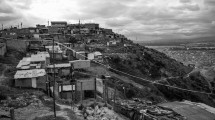Abstract
Wildland-urban interface (WUI) fires occur when fire spreads through both wildland and community (structures and vegetation) fuels. These fires are capable of causing significant destruction to both the built and the natural environments. When these fires occur under extreme fire danger conditions (e.g., high winds, low humidity) and in areas of significant population (e.g., San Diego, California) firefighters, and other emergency responders, are significantly challenged by the combination of firefighting and aiding the public. This paper presents the results of an in-depth case study of a community of 274 residences which was subjected to two wildland fires (within 2.5 h of each other) during the October 2007 firestorm in southern California. A significant amount of effort was spent obtaining information from residents and emergency responders to determine the fire spread timeline, structure ignition mechanisms, and defensive actions. Of the 274 residences, 245 were within the fire perimeter, 74 were destroyed, and 16 were damaged. When the first fire front arrived, the rate of structure ignitions peaked at 21 per hour. Direct and indirect ember, or firebrand, attack was responsible for the ignition of 2/3 of the destroyed homes. Defensive actions were taken on one of every three homes. Of the 16 damaged homes, 15 were successfully defended. Further study of this community is ongoing to investigate what currently recommended pre-fire hazard reduction actions could be, and were, implemented and their effectiveness at reducing the likelihood of structure ignition.































Similar content being viewed by others
Notes
Certain commercial entities, equipment, or materials may be identified in this document in order to describe an experimental procedure or concept adequately. Such identification is not intended to imply recommendation or endorsement by the National Institute of Standards and Technology, nor is it intended to imply that the entities, materials, or equipment are necessarily the best available for the purpose.
References
BFRL Initiates Studies of Wildland/Urban Interface (WUI) Fires, BFRL activities, accomplishments and recognitions. http://www.bfrl.nist.gov/Annual/2004-2005/BFRL06.pdf. Accessed 11 January 2010
NFPA 1144, Standard for reducing structure ignition hazards from wildland fire 2008 edition. NFPA, Quincy, MA
The 20 Largest Califirnia Wildland Fires (By Structures Destroyed), CALFIRE communication, 12 January 2009. http://www.fire.ca.gov/communications/downloads/fact_sheets/20LSTRUCTURES.pdf. Accessed 11 January 2010
Karter MJ, NFPA reports: U.S. fire loss for 2007, NFPA. www.nfpa.org. Accessed 11 January 2010
NIST, Wildland urban interface fire program. http://fire.nist.gov/wui. Accessed 11 January 2010
Mell WE, Jenkins MA, Gould J, Cheney P (2007) A physics-based approach to modeling grassland fires, Intl. J. Wildland Fires, 16: 1-22
Mell WE, Maranghides A, McDermott R, Manzello SL (2009) Combust Flame 156:2023–2041
Rehm RG, Mell WE (2009) A simple model for wind effects of burning structures and topography on wildland-urban interface surface-fire propagation, Intl. J. Wildland Fire 18, 290-301
Manzello SL, Park S-H, Cleary TG (2009) Investigation on the ability of glowing firebrands deposited within crevices to ignite common building materials, Fire Safety Journal, 44: 894-900
Manzello SL, Maranghides A, Sheilds JR, Mell WE, Hayashi Y, Nii D (2009) Fire Mater 33:21–31
Butry D and Donovan G. (2008) Protect thy neighbor: Investigating the spatial externalities of community wildfire hazard mitigation, Forest Science 54, 417- 428
Mell WE, Manzello SL, Maranghides A, Butry D, Rehm RG (to appear) The Wildland-urban interface fire problem: current approaches and research needs. Int J Wildland Fire
Howard RA, North DW, Offensend FL, Smart CN (1973) Decision analysis of fire protection strategy for the Santa Monica mountains: an initial assessment. Menlo Park, CA: Stanford Research Institute
Foote E (1996) Structural survival on the 1990 Santa Barbara “Paint” fire: a retrospective study of urban wildland interface fire hazard mitigation factors. MS thesis, University of California at Berkeley
Murphy K, Rich T, Sexton T (2007) An assessment of fuel treatment effects on fire behavior, suppression and structure ignition on the angora fire, USDA, R5-TP-025, August 2007
Cohen JD, Stratton RD (2008) Home destruction examination: grass valley. Fire, Lake Arrowhead, CA, USDA, R5-TP-026b
Mega Fires (July 2008) The case for mitigation. Institute for Business and Home Safety
Leonard JE, Blanchi R (2005) Investigation of bushfire attack mechanisms resulting in house loss in the ACT bushfire 2003. A CRC bushfire report. Bushfire CRC report CMIT technical report––2005-478. April 2005
After Action Report, October 2007 wildfires city of San Diego response. http://www.sandiego.gov/mayor/pdf/fireafteraction.pdf. Accessed 11 January 2010
CALFIRE Investigation Report, CA-CDF-010432 (Witch Fire). http://www.fire.ca.gov/fire_protection/downloads/redsheet/CA-MVU-010432_Complete.pdf. Accessed 11 January 2010
CALFIRE Investigation Report, CA-CDF-010484 (Guejito Fire). http://www.fire.ca.gov/fire_protection/downloads/redsheet/CA-MVU-010484_Complete.pdf. Accessed 11 January 2010
MesoWest website California region. http://www.met.utah.edu/cgi-bin/droman/mesomap.cgi?state=CA&rawsflag=3. Accessed 11 January 2010
Witch Incident CA MVU 010432 10/23/2007 Fuel Map, CALFIRE
Glossary of Wildland Fire Terminology, PMS 205, November 2008. A Publication of the National Wildfire Coordinating Group
Firewise website. www.firewise.org. Accessed 11 January 2010
Acknowledgements
The authors would like to acknowledge the critical contributions from CALFIRE Chief Ernylee Chamlee, San Diego Fire Department Chief Tracy Jarman, and San Diego Police Department Chief William Lansdowne. Additionally, the authors would like to acknowledge Mr. Steve Arnold, President of The Trails Home Owners Association, for his critical contributions in organizing the data collection efforts with The Trails residents and Jimmy Zurenko for his data collection support. Lastly, the authors would like to thank residents of The Trails and of the city of Poway. Collaboration with Dr. Samuel Manzello of NIST has been an important element of this work and is gratefully acknowledged.
Author information
Authors and Affiliations
Corresponding author
Rights and permissions
About this article
Cite this article
Maranghides, A., Mell, W. A Case Study of a Community Affected by the Witch and Guejito Wildland Fires. Fire Technol 47, 379–420 (2011). https://doi.org/10.1007/s10694-010-0164-y
Received:
Accepted:
Published:
Issue Date:
DOI: https://doi.org/10.1007/s10694-010-0164-y




